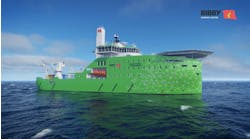Support vessel/marine services group Bourbon plans further investment in its global offshore fleet, to meet long-term demand for more modern tonnage.
In late 2005, the company announced a comprehensive vessel overhaul/construction program, in response to new requirements from the offshore, bulk, and port towage sectors. Late last year, however, Bourbon sold its port towage business, leaving it free to focus on its Offshore and Bulk Transport divisions.
During the intervening period, the offshore industry also had undergone further changes. Project costs were rising more quickly than anticipated two years earlier, but in parallel, growth was being slowed by equipment bottlenecks. As a result, operators looked set to extend their field investments over a longer period, thereby prolonging the production cycle.
TheBourbon Opale is one of the newer multi-purpose supply vessels in Bourbon’s fleet (copyright: Bourbon).
Under Bourbon’s new five-year plan, Horizon 2012, the company aims to support this long-term program via a series of new generation, high performance vessels and an expanded range of subsea services. This will involve allocating additional investments totaling €1.7 billion ($2.67 billion) to the Offshore Division.
The latter has been reorganized into two new activities: 1. Marine Services, encompassing offshore support vessels, crewboats, and salvage tugs; and 2. Subsea Services, comprising Engineering and Management, IMR Vessels (Inspection, Maintenance, and Repair), and ROV Services.
Currently Bourbon’s fleet comprises 230 offshore vessels – average age 6.7 years – with a further 182 on order.
“Last year we sold some of our older vessels,” says chief operating officer, Christian Lefevre, “and we still have various others classified as ‘additional.’ Basically, our policy is that we have to sell our oldest vessels when they are coming free from their charters. We believe we are investing twice as much in new tonnage as any of our competitors, at least the publicly listed ones. The majority of our orders have been placed with the Sinopacific Shipbuilding Group, with some also being handled by the Bharati shipyard in India, two shipyards in France, and others in Nigeria, Vietnam, and Brazil.”
Recently, Bourbon took delivery of the first of a large batch of vessels from the Sinopacific Shipyard. The new GPA 254/654 series is designed for anchor handling and transfer of supplies; reduced fuel consumption thanks to a diesel-electric propulsion system; and improved maneuverability, provided by integrated azimuth 360° directional thrusters.
Earlier this year, the company commissioned another 10 IMR vessels of the new GPA 696 design from Sinopacific. They are to be built in series at the Zheijiang shipyard in Ningbo, close to Shanghai, with deliveries due to start early in 2010. According to Michel Gondolo, who manages Bourbon’s IMR services activity, these vessels will be available for deepwater activity worldwide. They will join the existing pool of 11 IMR multi-purpose supply vessels (MPSVs) which have been providing deepwater field maintenance in some cases under long-term contracts since 2004.
These new MPSVs include DP-3 dynamic positioning; heave-compensated cranes capable of deploying loads in water depths of up to 3,000 m (9,842 ft); a large deck capacity; and accommodation for a crew of 100. Their duties typically are installation of flexible and rigid connections and wellheads; replacing the housing containing electronics for subsea wellheads; connecting or replacing umbilicals and electrical cables; and remote control of manifolds.
“It is not our intention to be in competition with the largest subsea contractors,” Gondolo points out. “Their market is more in development capex, whereas we are targeting production opex, which involves different tools. Also, the size of our vessels is more in line with IMR than construction requirements. From time to time, however, we can support these big specialists when they lack resources in their fleets.
“We are operating in West Africa. The type of vessels needed in this area depends on what happens in the life of the field. At the beginning, larger vessels are required for construction activity, and then lighter vessels are needed for maintenance and inspection. Later on, larger vessels are again necessary to support well intervention, to revive production, or to maintain plateau output. Our target is to meet these needs long-term, although our clients in this region do not yet have a life-of-field contracting strategy in terms of vessels.”
In December 2007, Bourbon also gained a fleet of seven observer- and work-class ROVs by acquiring DNT Offshore, which since has been integrated into the Subsea Services division. This company, established since 2002 in Ravenna, Italy, provides electric SeaEye Cougar- and SeaEye Falcon-type ROVs for inspection tasks associated with offshore surveys, construction, drilling, and decommissioning.
“DNT has its own markets and activity, and we have no plans to modify its positioning,” Gondolo says. “However, we are investing in new assets – 14 ROVs to be delivered by 2012 – in order to provide a full IMR services package. A first order has been placed with Schilling for four of its 200hp UHD vehicles, capable of operating in 4,000 m (13,123 ft) water depth. Deliveries should be made in 2008 and 2009.
“We will support them in recruiting more technicians and ROV pilots, aligning their expertise with our quality and safety standards, and transferring their skills to our fleet where applicable. We are also investing in an ROV training center via a new simulator facility which DNT will procure and manage in Ravenna.”





